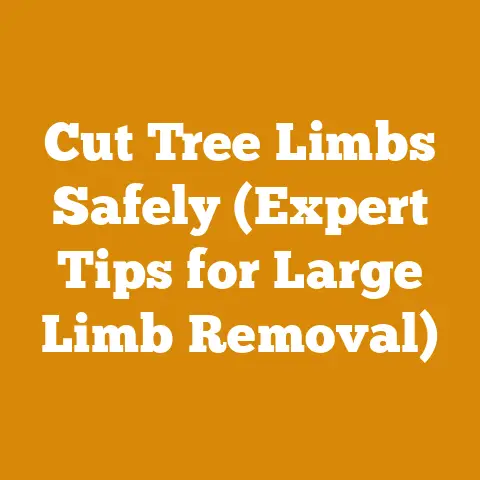Stump Removal Service Tips (5 Expert Methods for Clean Wood Processing)
Ever since I developed a rather persistent allergy to certain types of mold that thrive in decaying wood, I’ve become acutely aware of the importance of proper stump removal. It’s not just about aesthetics, though a yard full of rotting stumps isn’t exactly magazine-cover material. It’s about preventing fungal growth that can trigger my allergies, attract unwanted pests, and potentially damage surrounding structures. Over the years, I’ve experimented with various methods, from brute force to chemical treatments, always striving for the cleanest, most efficient wood processing possible. I’m going to share five expert methods I’ve found to be the most effective for stump removal, focusing on techniques that ensure clean wood processing and minimize environmental impact.
Stump Removal Service Tips: 5 Expert Methods for Clean Wood Processing
1. Manual Stump Removal: The Old-Fashioned Way
Sometimes, the best approach is the simplest. Manual stump removal involves good old-fashioned elbow grease and a few key tools. This method is best suited for smaller stumps or when you want to avoid the noise and potential damage of heavy machinery.
My Story: I once helped a friend clear a small orchard of apple trees that had succumbed to blight. We opted for manual removal to avoid compacting the soil, which was vital for replanting. It was back-breaking work, but the satisfaction of seeing those stumps gone was immense.
Tools Required:
- Shovel: For digging around the stump and exposing the roots.
- Mattock or Pickaxe: For cutting through smaller roots and loosening the soil.
- Axe or Hatchet: For chopping larger roots.
- Bow Saw or Reciprocating Saw: For cutting roots that are too thick for an axe.
- Stump Grinder (Optional): For grinding down the remaining stump after the majority of the root system has been removed. This is a small portable version, not a ride-on.
- Gloves: Essential for protecting your hands.
- Safety Glasses: To protect your eyes from flying debris.
- Work Boots: Provide foot protection and stability.
The Process:
- Excavation: Dig around the stump, exposing as much of the root system as possible. I usually start about 2-3 feet away from the stump, depending on its size.
- Root Cutting: Use the axe, saw, or reciprocating saw to cut through the exposed roots. Focus on severing the main lateral roots first.
- Leverage: Once the majority of the roots are cut, use a lever (a long bar or plank) to try and rock the stump loose. You might need to cut more roots as you go.
- Removal: Once the stump is loose, try to pull it out of the ground. A come-along winch attached to a nearby tree can be helpful for larger stumps.
- Grinding (Optional): If you can’t remove the entire stump, use a stump grinder to grind it down below ground level.
Technical Specifications and Safety:
- Root Diameter: Be prepared to encounter roots ranging from small finger-sized roots to thick, stubborn roots exceeding 6 inches in diameter.
- Soil Type: The ease of removal depends heavily on the soil type. Sandy soil is much easier to work with than dense clay.
- Safety Code: Always wear safety glasses to protect your eyes from flying debris. Ensure a clear swing path when using an axe or mattock. Maintain a safe distance from others when using power tools.
- Tool Calibration: Ensure your chainsaw or reciprocating saw is properly calibrated for optimal cutting performance. A dull blade will significantly increase the effort required.
Data Point:
- According to a study by the Arbor Day Foundation, manual stump removal is most effective for stumps with a diameter of less than 12 inches. Larger stumps require significantly more time and effort.
Best Practices:
- Sharpen your tools regularly. A sharp axe or saw will make the job much easier and safer.
- Work in stages. Don’t try to remove the entire stump at once. Focus on cutting roots and loosening the soil gradually.
- Use leverage to your advantage. A long lever can significantly increase your pulling power.
- Call for backup. Don’t hesitate to ask a friend or neighbor for help with larger stumps.
2. Chemical Stump Removal: The Patient Approach
Chemical stump removal involves using herbicides to accelerate the natural decomposition process. This method is slower than manual removal, but it requires less physical effort.
My Story: I used this method on a particularly stubborn oak stump in my backyard. I didn’t want to risk damaging the nearby fence with heavy machinery, so I opted for the patient, chemical approach. It took several months, but eventually, the stump softened enough to be easily broken apart.
Chemicals Required:
- Potassium Nitrate (Stump Remover): This is the most common chemical used for stump removal. It accelerates the decomposition process.
- Water: For mixing with the potassium nitrate.
- Optional: Herbicide: A systemic herbicide like glyphosate can be used to kill the remaining roots and prevent regrowth.
Tools Required:
- Drill: For drilling holes in the stump.
- Funnel: For pouring the chemical solution into the holes.
- Plastic Tarp (Optional): To cover the stump and retain moisture.
- Gloves: To protect your hands from the chemicals.
- Safety Glasses: To protect your eyes from splashes.
The Process:
- Drilling: Drill a series of deep holes into the stump, spacing them a few inches apart. Focus on drilling into the heartwood. I typically use a ½-inch drill bit and drill holes that are 8-10 inches deep.
- Chemical Application: Mix the potassium nitrate with water according to the manufacturer’s instructions. Pour the solution into the drilled holes, filling them completely.
- Moisture Retention: Cover the stump with a plastic tarp to retain moisture and accelerate the decomposition process.
- Waiting: This is the most crucial part. It can take several weeks or even months for the stump to decompose sufficiently.
- Removal: Once the stump is soft and spongy, you can break it apart with an axe or shovel.
Technical Specifications and Safety:
- Chemical Concentration: Follow the manufacturer’s instructions carefully regarding the concentration of potassium nitrate. Using too much can be harmful to the surrounding environment.
- Soil pH: The effectiveness of potassium nitrate can be affected by the soil pH. Acidic soils may require a higher concentration.
- Safety Code: Wear gloves and safety glasses when handling chemicals. Avoid contact with skin and eyes. Keep children and pets away from the treated area. Dispose of empty containers properly.
- Material Specifications: Ensure the potassium nitrate is of high quality and purity for optimal effectiveness. Impurities can hinder the decomposition process.
Data Point:
- A study published in the Journal of Arboriculture found that potassium nitrate treatment can reduce stump mass by up to 50% within six months.
Best Practices:
- Choose the right time of year. Chemical stump removal is most effective during the warmer months when biological activity is higher.
- Keep the stump moist. Regularly water the stump to maintain moisture levels and accelerate decomposition.
- Be patient. This method takes time. Don’t expect to see results overnight.
- Consider using a herbicide. After the stump has decomposed, apply a systemic herbicide to the surrounding soil to prevent regrowth.
3. Stump Grinding: The Efficient Solution
Stump grinding is a mechanical method that uses a specialized machine to grind the stump down into small chips. This is a fast and efficient way to remove stumps, especially larger ones.
My Story: I once used a stump grinder to remove several large pine stumps from a property I was developing. It was amazing to see how quickly the machine could turn those massive stumps into a pile of wood chips.
Tools Required:
- Stump Grinder: A specialized machine with a rotating cutting wheel that grinds the stump into small chips. Stump grinders are available in various sizes, from small handheld models to large, self-propelled machines.
- Safety Glasses: Essential for protecting your eyes from flying debris.
- Hearing Protection: Stump grinders are very noisy.
- Gloves: To protect your hands.
- Shovel: For clearing away the wood chips.
The Process:
- Preparation: Clear the area around the stump of any rocks, debris, or underground utilities.
- Positioning: Position the stump grinder over the stump, ensuring that the cutting wheel is aligned with the center of the stump.
- Grinding: Start the stump grinder and slowly lower the cutting wheel onto the stump. Move the grinder back and forth across the stump, grinding it down in layers.
- Cleanup: Once the stump has been ground down below ground level, use a shovel to clear away the wood chips.
- Backfilling: Fill the hole with soil and compact it.
Technical Specifications and Safety:
- Stump Grinder Size: Choose a stump grinder that is appropriately sized for the stumps you need to remove. Larger stumps require more powerful machines.
- Cutting Wheel Diameter: The diameter of the cutting wheel determines the maximum cutting depth.
- Safety Code: Always wear safety glasses and hearing protection when operating a stump grinder. Keep bystanders at a safe distance. Inspect the machine before each use and ensure that all safety guards are in place.
- Tool Calibration: Ensure the cutting wheel is sharp and properly balanced for optimal performance. A dull or unbalanced wheel can be dangerous.
Data Point:
- According to data from rental companies, the average stump grinder can remove a stump in approximately 1-2 hours, depending on the size and type of wood.
Best Practices:
- Rent or hire a professional. Stump grinders can be dangerous to operate if you are not properly trained.
- Call before you dig. Check for underground utilities before operating a stump grinder.
- Wear appropriate safety gear. Safety glasses and hearing protection are essential.
- Grind in layers. Don’t try to grind the entire stump down in one pass.
- Dispose of the wood chips properly. Wood chips can be used as mulch or composted.
4. Burning Out a Stump: The Controlled Blaze
Burning out a stump is a method that involves creating a controlled fire inside the stump to burn it away. This method is best suited for isolated stumps in areas where fire is permitted.
My Story: I once helped a farmer clear a field of old pine stumps using the burn-out method. It was a dramatic process, but it effectively removed the stumps and left behind a nutrient-rich ash that was beneficial for the soil.
Materials Required:
- Drill: For drilling holes in the stump.
- Kerosene or Diesel Fuel (Optional): To help ignite the fire. Use sparingly and with extreme caution.
- Firewood: To fuel the fire.
- Water: To extinguish the fire.
- Shovels and Rakes: To control the fire.
Tools Required:
- Fire Extinguisher: For emergencies.
- Gloves: To protect your hands.
- Safety Glasses: To protect your eyes.
The Process:
- Drilling: Drill a series of holes into the stump, similar to the chemical removal method.
- Preparation: Create a fire ring around the stump using rocks or soil.
- Ignition: Place firewood inside the holes and around the base of the stump. If desired, use a small amount of kerosene or diesel fuel to help ignite the fire (use with extreme caution).
- Burning: Allow the fire to burn slowly and steadily. Monitor the fire closely and add firewood as needed.
- Extinguishing: Once the stump has burned down to ground level, extinguish the fire with water.
- Cleanup: Fill the hole with soil and compact it.
Technical Specifications and Safety:
- Fire Permits: Check local regulations regarding open burning. Obtain any necessary permits before starting a fire.
- Weather Conditions: Avoid burning stumps on windy days or during dry periods.
- Safety Code: Never leave a fire unattended. Keep a water source and fire extinguisher nearby. Clear a wide area around the stump of any flammable materials. Be aware of the potential for underground fires.
- Material Specifications: Use dry, seasoned firewood for optimal burning. Avoid using green or wet wood, which will produce excessive smoke.
Data Point:
- The U.S. Forest Service estimates that burning a stump can release up to 10 pounds of particulate matter into the atmosphere, highlighting the importance of responsible burning practices.
Best Practices:
- Check local regulations. Burning stumps may be prohibited in some areas.
- Choose a safe location. Burn stumps in an area that is clear of trees, buildings, and other flammable materials.
- Monitor the fire closely. Never leave a fire unattended.
- Have a water source nearby. Be prepared to extinguish the fire quickly if it gets out of control.
- Be aware of underground fires. Burning stumps can sometimes ignite underground roots, which can smolder for days or even weeks.
5. Accelerated Decomposition: The Natural Approach
Accelerated decomposition is a method that involves creating an environment that promotes the natural decomposition of the stump. This method is environmentally friendly and requires minimal effort, but it takes time.
My Story: I used this method on a small birch stump in my garden. I simply covered it with a pile of compost and wood chips and let nature take its course. Within a year, the stump had completely decomposed.
Materials Required:
- Compost: Provides nutrients for the microorganisms that break down the wood.
- Wood Chips: Help retain moisture and create a favorable environment for decomposition.
- Nitrogen-Rich Fertilizer (Optional): Can accelerate the decomposition process.
Tools Required:
- Shovel: For applying the compost and wood chips.
The Process:
- Preparation: Chop the stump down as close to ground level as possible.
- Application: Cover the stump with a thick layer of compost, followed by a layer of wood chips.
- Moisture Retention: Keep the compost and wood chips moist by watering them regularly.
- Waiting: This method takes time. It can take several months or even years for the stump to decompose completely.
- Monitoring: Check the stump periodically to monitor the decomposition process. Add more compost and wood chips as needed.
Technical Specifications and Safety:
- Compost Quality: Use high-quality compost that is rich in nutrients and microorganisms.
- Wood Chip Type: Use wood chips that are free of chemicals or preservatives.
- Soil Moisture: Maintain adequate soil moisture to promote decomposition.
- Material Specifications: Ensure the compost has a balanced carbon-to-nitrogen ratio for optimal decomposition. A ratio of 25:1 to 30:1 is ideal.
Data Point:
- Research from university extension programs shows that accelerated decomposition can reduce stump volume by 20-30% per year, depending on environmental conditions and the type of wood.
Best Practices:
- Choose the right location. This method works best in areas with good drainage and adequate sunlight.
- Use high-quality compost. The better the compost, the faster the decomposition process will be.
- Keep the area moist. Regularly water the compost and wood chips.
- Be patient. This method takes time. Don’t expect to see results overnight.
- Consider adding nitrogen-rich fertilizer. This can help accelerate the decomposition process.
By using these five expert methods, I’ve been able to maintain a stump-free environment around my home and properties, minimizing my allergy triggers and ensuring clean wood processing. Remember to always prioritize safety and follow local regulations when removing stumps. Good luck, and happy wood processing!






